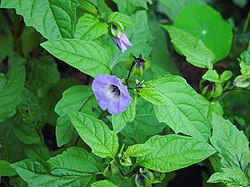Nicandra physalodes
| Height: | ⇕ | 1 m"m" can not be assigned to a declared number type with value 1. |
|---|
| Features: | ✓ | flowers |
|---|---|---|
| Flower features: | ❀ | purple, white |
|
Nicandra > |
If this plant info box on watering; zones; height; etc. is mostly empty you can click on the edit tab and fill in the blanks!
Nicandra is a monotypic genus of flowering plants in the nightshade family containing the single species Nicandra physaloides. It is known by the common names Apple of Peru and shoo-fly plant. It is native to Peru, and it is known elsewhere as an introduced species and sometimes a weed. It is also kept as an ornamental plant.
Plants grow to 1 metre tall and are vigorous with spreading branches and ovate, mid-green, toothed and waved leaves. The flowers are bell-shaped and 5 centimeters or more across, pale violet with white throats. The flower becomes lantern-like towards the end of its bloom. The plant is thought to have insect repellent properties.[1]
The genus is named for Greek poet Nicander, who wrote about plants.[2]
Read about Nicandra physalodes in the Standard Cyclopedia of Horticulture
|
|---|
|
Nicandra physalodes, Pers. (Atropa physalodes, Linn. Physalodes peruvianum, Kuntze. N. physaloides, Gaertn.). Known as Apple-of-peru, a strong spreading annual, 3-4 ft. high, grown for the showy blue fls. and odd frs.: glabrous: Lvs. elliptic or elliptic-ovate, sinuate and toothed, narrowed into a prominent petiole: fls. solitary in the axils, on recurving pedicels, an inch or more across, shaped like a potato flower, the corolla blue or bluish: fr. a thin-walled and nearly or quite dry berry, inclosed in an enlarged, strongly 5-winged calyx.—The apple-of-Peru is an old-fashioned garden annual, now rarely seen. It has escaped from cult, in some places in the U. S., and it is now widely distributed in the tropics. It is often confounded with the ground cherry and alkekengi, which are species of Physalis.
|
Read about Nicandra physalodes in the Standard Cyclopedia of Horticulture
|
|---|
|
Nicandra (Nicander, poet of Colophon, wrote on plants about 100 B.C.). Syn. Physalodes. Solanaceae. One Peruvian herb differing from Physalis chiefly in the 3-5-loculed ovary and dry rather than fleshy fr., and in the larger and more showy fls., of which the corolla is nearly entire. Lately a second species has been described, perhaps a variant. N. violacea, Andre. Vigorous branched annual, glabrous or sometimes the Lvs. hairy on upper side: Lvs. subtriangular, the cauline reaching 10 in. long and 5 in. broad, coarsely toothed or lobed: fls. solitary, axillary and short-pedicelled; calyx large, dark violet on lower naif, the lobes cordate: corolla violet-blue above and white on lower half, campanulate, to 1½ in. broad. Probably S. Amer.—Distinguished from N. Physalodes particularly by the prominently blue corolla and calyx and similar color on the sts., petioles and peduncles, and the scattered colored hairs on upper surface of Lvs.
|
Cultivation
Propagation
Pests and diseases
Varieties
Gallery
References
- Standard Cyclopedia of Horticulture, by L. H. Bailey, MacMillan Co., 1963
External links
- w:Nicandra physalodes. Some of the material on this page may be from Wikipedia, under the Creative Commons license.
- Nicandra physalodes QR Code (Size 50, 100, 200, 500)

